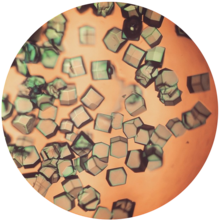
Back ليزوزيم Arabic লাইসোজাইম Bengali/Bangla Lizozim BS Lisozim Catalan Lysozym Czech LYZ Welsh Lysozym Danish Lysozym German Λυσοζύμη Greek Lisozima Spanish
| Glycoside hydrolase, family 22, lysozyme | |
|---|---|
 Lysozyme crystals stained with methylene blue. | |
| Identifiers | |
| Symbol | ? |
| InterPro | IPR000974 |
Lysozyme (EC 3.2.1.17, muramidase, N-acetylmuramide glycanhydrolase; systematic name peptidoglycan N-acetylmuramoylhydrolase) is an antimicrobial enzyme produced by animals that forms part of the innate immune system. It is a glycoside hydrolase that catalyzes the following process:
- Hydrolysis of (1→4)-β-linkages between N-acetylmuramic acid and N-acetyl-D-glucosamine residues in a peptidoglycan and between N-acetyl-D-glucosamine residues in chitodextrins
Peptidoglycan is the major component of gram-positive bacterial cell wall.[1] This hydrolysis in turn compromises the integrity of bacterial cell walls causing lysis of the bacteria.
Lysozyme is abundant in secretions including tears, saliva, human milk, and mucus. It is also present in cytoplasmic granules of the macrophages and the polymorphonuclear neutrophils (PMNs). Large amounts of lysozyme can be found in egg white. C-type lysozymes are closely related to α-lactalbumin in sequence and structure, making them part of the same glycoside hydrolase family 22.[2] In humans, the C-type lysozyme enzyme is encoded by the LYZ gene.[3][4]
Hen egg white lysozyme is thermally stable, with a melting point reaching up to 72 °C at pH 5.0.[5] However, lysozyme in human milk loses activity very quickly at that temperature.[6] Hen egg white lysozyme maintains its activity in a large range of pH (6–9).[7] Its isoelectric point is 11.35.[8] The isoelectric point of human milk lysozyme is 10.5–11.[9]
- ^ Manchenko GP (1994). "Lysozyme". Handbook of Detection of Enzymes on Electrophoretic Gels. Boca Raton, Fla.: CRC Press. p. 223. ISBN 978-0-8493-8935-1.
- ^ Williams S, Vocadlo D. "Glycoside hydrolase family 22". Cazypedia. Retrieved 11 April 2017.
- ^ Yoshimura K, Toibana A, Nakahama K (January 1988). "Human lysozyme: sequencing of a cDNA, and expression and secretion by Saccharomyces cerevisiae". Biochemical and Biophysical Research Communications. 150 (2): 794–801. doi:10.1016/0006-291X(88)90461-5. PMID 2829884.
- ^ Peters CW, Kruse U, Pollwein R, Grzeschik KH, Sippel AE (July 1989). "The human lysozyme gene. Sequence organization and chromosomal localization". European Journal of Biochemistry. 182 (3): 507–516. doi:10.1111/j.1432-1033.1989.tb14857.x. PMID 2546758.
- ^ Venkataramani S, Truntzer J, Coleman DR (April 2013). "Thermal stability of high concentration lysozyme across varying pH: A Fourier Transform Infrared study". Journal of Pharmacy & Bioallied Sciences. 5 (2): 148–153. doi:10.4103/0975-7406.111821. PMC 3697194. PMID 23833521.
- ^ Chandan RC, Shahani KM, Holly RG (October 1964). "Lysozyme Content of Human Milk". Nature. 204 (4953): 76–77. Bibcode:1964Natur.204...76C. doi:10.1038/204076a0. PMID 14240122. S2CID 4215401.
- ^ "Lysozyme, Product information" (PDF). Sigma-Aldrich.
- ^ "Lysozyme, Product information" (PDF). Sigma-Aldrich.
- ^ Parry RM, Chandan RC, Shahani KM (March 1969). "Isolation and characterization of human milk lysozyme". Archives of Biochemistry and Biophysics. 130 (1): 59–65. doi:10.1016/0003-9861(69)90009-5. PMID 5778672.